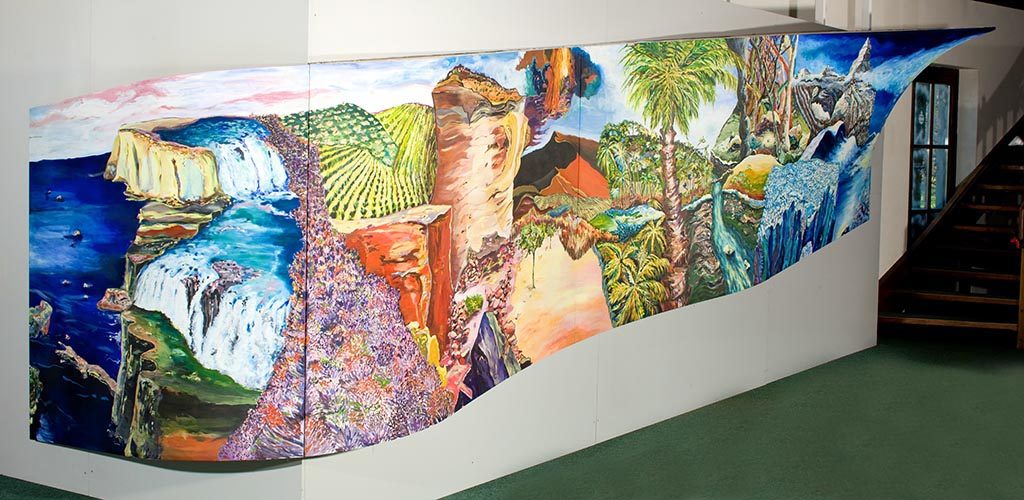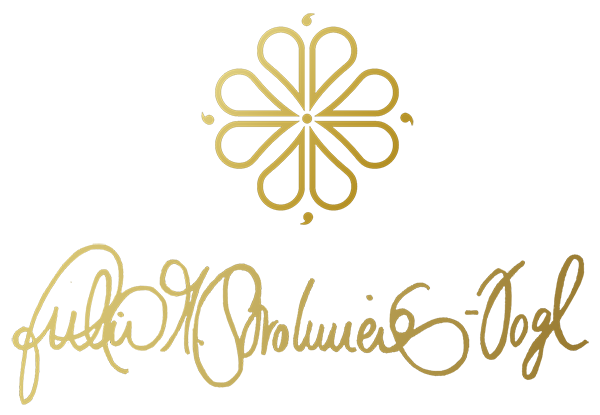“In Harmony with Nature”
Julia-Maria Strohmeier (born 1984 in Austria),
Has lived and worked in London since June 2013. She studied painting at the University of Applied Arts in Vienna. During her studies, Julia discovered her love for landscape painting. The source of her work is nature itself. Her diploma thesis “Radial Nature Zones” in 2007 marked the beginning of her three- dimensional work. From this point on, a number of paintings and objects were developed and created using convex and concave shapes around which the frames were constructed. Since 2012, the ellipse/oval shape (symbolizing unity) is a further component of her artwork.
Due to this more intense viewing from different perspectives the picture come alive. The viewer is invited to enter through the secret door and emerge into the beauty of the landscape. In the pictures, the harmony of the original inspiration is restored. A conscious and respectful treatment of flora and fauna is inherent throughout her work, whilst the richness and lushness of her palette are, for her, vital means of expression.
“On the way to Paradise” – Art of the new dimensions
The principal of three-dimensionality
For Julia- Maria Strohmeier, the four elements Fire, Earth, Water and Light are not only the fundamental base of all human being but also the source of inspiration for her work. In 2007, when she spent several weeks in the jungles of Peru and Bolivia, the idea of using three-dimensional formats for her paintings was born. Due to the concave and convex shapes, her motives become alive. Depending on the location of the viewer, her paintings keep revealing new details and objects, that were hidden before. “Actually, for me, vastness equals infinity.”
The young artist has been attracting attention with various exhibitions as well as with contract work, where the client’s personal wishes are crucial. The client’s choice of the final location of her art is a major criteria in her working process, as the frame and the format are specifically designed and concstructed in order to perfectly fit in, considering the individual surroundings.
“Paradise as a symbol for human needs“
Everyone imagines Paradise differently. For me, it is the lushness and plentitude of nature. I aim to create paintings in which the viewers can keep discovering new things. I am convinced that people should surround themselves with plentitude in order to invite it into their lives. The things we think about, the things we surround ourselves with on a daily basis – this is what enters our lives. That applies to personal relationships, professional life and all other areas in life.”
For the young artist, the core of her work is the human urge towards perfection and a new kind of art of becoming conscious and aware. “In the end, everyone of us is aiming to reach perfection. Paradies isn’t making its own way to us, after all – we have to do our part to experience it. Many people don’t have the courage to dig deeper, they often don’t know what they actually want and are rarely willing to make changes in their lives. If one is ready and happy to change him- or herself, then this will attract different and new people. Paradise has to be found within oneself.
“Diploma thesis”
First of all the thesis “Radial Nature Zones”, was just surprise at the beginning. Surprise at dimensions; and about the convex and concave wooden picture frame covered with canvas, in the dimensions 140 x 800cm / 55.1 x 314.9 ins. Surprise at the amount of feelings and inflation reasons, the complexity and structure of the composition, the raw style and also the subtlety of colour and shape. A loud language (but) with internal expression and with young people´s ease. There is about a year between the thesis and the “Nymphaea”; in between the majority of the radial work. We know Monet`s “Nymphaea” series.
The optical thought: Monet avoids the direct withdrawing of the colour surface which leads to an immaterial repetition. – Mirroring. Julia-Maria Strohmeier`s eye is not like the classic Impressionists´ last instance of the experience. Her work is essentially autonomous and not historically influenced. The motive is not an unimportant occasion – it is pure expression. All art is form, which means there is art where the form shows a special accentuation. There is also art in which all art is expression. This means in other words the expression presents a special accent. In the 1920s a generation of artists came , who particularly attributed weight on the expression. It´s not Julia Maria Strohmeier`s intention to forget formal operations. If it happens that form and expression in her pictures get doubled then only in order to work out a much better graphical intention. The expressionism is something like a constant in the Austrian painting.
The accents in her landscape paintings are in these fields; in an increasing emotional sphere. Her works show this expression. Form in Julia-Maria Strohmeier`s works means images as composition, but also how to handle the subject. These images are (deliberately) composed, simple and complicated, built and divided and incorporated in the image. The image framework does not impose. The last word in her work has always the colour. A question of art is the relationship between the real and abstract. For Julia-Maria Strohmeier the question is not as either/or. She gives nature a special right within her pictures without destroying its character totally. Nature becomes subject (seemingly in a traditional way) in her paintings. The last word in her painting has always the color, not the composition, not the line …, it is the key expression. The colour in Julia-Maria Strohmeier pictures is shown in a rich, polychrome, dense range. The color becomes substance which forms reality.
A target in her work is to dense constants in her painting.
August Macke said: “You are not allowed to paint with a view to nature. You should paint with a look at the picture, the palette and the colours”. In a way these images have been made, they also should be seen – with distance
by Volker Schafschetzy (MA)
.

Radial Nature Zones 140 x 800 cm / 55.1 x 314.9 ins
“Radial Nature Zones”
My diploma thesis “Radial Nature Zones” describes a 3 dimensional panorama construction measuring 314.9 inch length. Three-D refers to the construction which features concave, convex as well as horizontal and vertical radii. Through the different points of view, elemental segments of nature can be perceived most diverse. Furthermore the construction amplifies and produces an especially changing dynamic and movement. The 8oo cm / 314.9 ins long constructions exhibit a heightening of 60cm / 23.6 ins in total. From the left side onwards the element Water, leading to Fire and Earth and finishing with the element of Air on the highest point. Through montage I have unified global sections of diverse scenery, which are divided through existing clime zones.
My subjective global sensation about unified impacts of elemental components is manifested in my personal ideal scenery. The seeding primal ocean is the first part of the painting, with it’s right side edge in a 90° angle towards the main view of the painting. Main focus on the second part leads to the change of spacious veldt scenery. According allegory I have positioned a Vulcan and the desert in the second section. To polarize the thirsty desert and the active Vulcan, the subtropics is placed in the third section. Representative for the 4th part of the painting is the cooling and pausing in the everlasting ice. Highest massif is surrounded by snow and ice. The element of Air is clear and cool about it. Spherical light entering the atmosphere produces changing, transforming warmth. Clouds nourished by water move across the sky and finalize the cycle of the elements eventually. It is through the radial forms and colour compositions in elemental areas, which give off a mystic dramatic in the entire painting.
